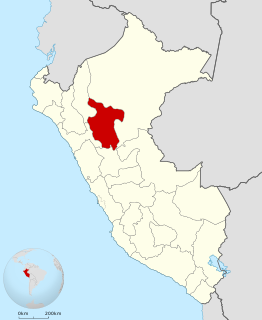| Huánuco Region | |||
|---|---|---|---|
| Region | |||
 The Huayhuash mountain range with Yerupajá, one of the highest peaks of Peru | |||
| |||
 Location of the Huánuco Region in Peru | |||
| Country | Peru | ||
| Subdivisions | 11 provinces and 76 districts | ||
| Largest city | Huánuco | ||
| Capital | Huánuco | ||
| Government | |||
| • Governor | Rubén Alva Ochoa (2015-2018) | ||
| Area | |||
| • Total | 36,848.85 km2 (14,227.42 sq mi) | ||
| Highest elevation | 3,839 m (12,595 ft) | ||
| Lowest elevation | 167 m (548 ft) | ||
| Population (2005 Census) | |||
| • Total | 730,871 | ||
| • Density | 20/km2 (51/sq mi) | ||
| UBIGEO | 10 | ||
| Dialing code | 062 | ||
| ISO 3166 code | PE-HUC | ||
| Principal resources | - | ||
| Poverty rate | 78.9% | ||
| Percentage of Peru's GDP | 1% | ||
| Website | www.regionhuanuco.gob.pe | ||

Huánuco (Spanish pronunciation: [ˈwanuko] ) is a region in central Peru. [1] It is bordered by the La Libertad, San Martín, Loreto and Ucayali regions in the north, the Ucayali Region in the east, the Pasco Region in the south and the Lima and Ancash regions in the west. Its capital is the city Huánuco.

Peru, officially the Republic of Peru, is a country in western South America. It is bordered in the north by Ecuador and Colombia, in the east by Brazil, in the southeast by Bolivia, in the south by Chile, and in the west by the Pacific Ocean. Peru is a megadiverse country with habitats ranging from the arid plains of the Pacific coastal region in the west to the peaks of the Andes mountains vertically extending from the north to the southeast of the country to the tropical Amazon Basin rainforest in the east with the Amazon river.
Contents
Huánuco has a rough topography comprising parts of the Sierra and the High Jungle (mountain rim) regions. Being equidistant from the north and the south of the country, it has the privilege of having a mild weather with an average annual temperature of 20°C (68°F).
This region is important for its geographical location, history, and for the richness of its land, where the presence of man goes back to ancient times. El Hombre de Lauricocha (Man of Lauricocha) is among the most distinctive examples, dating from 10,000 BC, as well as Kotosh, where vestiges of the oldest settlement in the Americas (4200 BC) took place.

The Americas comprise the totality of the continents of North and South America. Together, they make up most of the land in Earth's western hemisphere and comprise the New World.
Several ethnic groups inhabited this region. However, after a severe resistance, they started to incorporate as part of the Inca empire. Huánuco then became part of the Cusco-Cajamarca-Cusco route.
In the beginning of the 19th century, during the emancipation process, Huánuco was one of the first cities to promote Peru's independence. Moreover, a first oath took place in this city on December 15, 1820, after several uprisings in Huamalíes, Huallanca and Ambo.























